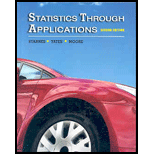
Concept explainers
a)
To perform hypothesis test for one sample proportion
a)
Answer to Problem 9.69RE
There is not sufficient evidence to support the claim that the majority of U.S. teens would say that young people should wait to have sex until they are married.
Explanation of Solution
Given:
Confidence level = 0.95
Claim: Proportion is higher than 50%.
Formula:
Sample proportion:
Test statistic:
Calculation:
The sample proportion is,
Null and alternative hypothesis:
This corresponding to a one-tailed test, for which a z-test for one population proportion needs to be used.
Test statistic:
Test statistic z = 2.53
Using the P-value approach:
The p-value is p = 0.0057
Using excel formula, =NORMSDIST(2.53)
And a = 0.05
Since p = 0.0057 <0.05, it is concluded that the Null Hypothesis is rejected.
Conclusion: There is not sufficient evidence to support the claim that the majority of U.S. teens would say that young people should wait to have sex until they are married.
b)
To find the confidence interval for population proportion.
b)
Answer to Problem 9.69RE
The 95% confidence interval is (0.514,0.607)
Explanation of Solution
Given:
Sample proportion:
Confidence level = c = 95% = 0.95
Sample size = n = 439
Formula:
Margin of error:
Confidence interval:
Confidence level = c = 95% = 0.95
So, level of significance = a = 1-0.95 = 0.05
Z a/2 = 1.96 …Using excel
Margin of error is,
Therefore, the 95% confidence interval is,
Hence, we are 95% confidence that the true population proportion of heads is between 0.514 and 0.607.
c)
To explain whether from inference a) and b), teens are actually telling the truth.
c)
Answer to Problem 9.69RE
No.
Explanation of Solution
Before using inference, we always assume that the truth was told. Therefore, inference does not determine whether truth actually told or not. Its just try to give evidence for given claim.
Chapter 9 Solutions
Statistics Through Applications
Additional Math Textbook Solutions
STATS:DATA+MODELS-W/DVD
Elementary Statistics (13th Edition)
Basic Business Statistics, Student Value Edition
Introductory Statistics
Basic Business Statistics, Student Value Edition (13th Edition)
Introductory Statistics (2nd Edition)
 MATLAB: An Introduction with ApplicationsStatisticsISBN:9781119256830Author:Amos GilatPublisher:John Wiley & Sons Inc
MATLAB: An Introduction with ApplicationsStatisticsISBN:9781119256830Author:Amos GilatPublisher:John Wiley & Sons Inc Probability and Statistics for Engineering and th...StatisticsISBN:9781305251809Author:Jay L. DevorePublisher:Cengage Learning
Probability and Statistics for Engineering and th...StatisticsISBN:9781305251809Author:Jay L. DevorePublisher:Cengage Learning Statistics for The Behavioral Sciences (MindTap C...StatisticsISBN:9781305504912Author:Frederick J Gravetter, Larry B. WallnauPublisher:Cengage Learning
Statistics for The Behavioral Sciences (MindTap C...StatisticsISBN:9781305504912Author:Frederick J Gravetter, Larry B. WallnauPublisher:Cengage Learning Elementary Statistics: Picturing the World (7th E...StatisticsISBN:9780134683416Author:Ron Larson, Betsy FarberPublisher:PEARSON
Elementary Statistics: Picturing the World (7th E...StatisticsISBN:9780134683416Author:Ron Larson, Betsy FarberPublisher:PEARSON The Basic Practice of StatisticsStatisticsISBN:9781319042578Author:David S. Moore, William I. Notz, Michael A. FlignerPublisher:W. H. Freeman
The Basic Practice of StatisticsStatisticsISBN:9781319042578Author:David S. Moore, William I. Notz, Michael A. FlignerPublisher:W. H. Freeman Introduction to the Practice of StatisticsStatisticsISBN:9781319013387Author:David S. Moore, George P. McCabe, Bruce A. CraigPublisher:W. H. Freeman
Introduction to the Practice of StatisticsStatisticsISBN:9781319013387Author:David S. Moore, George P. McCabe, Bruce A. CraigPublisher:W. H. Freeman





